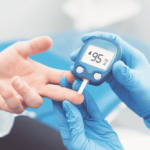By David G. Bunning and Dr. Thomas Casale
There’s nothing more terrifying than seeing your child, friend, or loved one stop breathing. However, millions of people across the country live with this fear every day. Once considered rare, food allergies now affect more than 32 million Americans. The number of children with food allergies has doubled to approximately 5.6 million in less than two decades and at the same time, adult food allergies are also on the rise. It’s not just children with food allergies maturing into adulthood that is driving the increase; of the more than 26 million U.S. adults with food allergies, nearly half developed at least one allergy in adulthood.
The growing prevalence of food allergies over the last two decades is also affecting America’s economy. Medical claims for the treatment of anaphylaxis, a severe and potentially life-threatening reaction, have increased 377 percent from 2007 to 2016. The annual costs of childhood food allergy are estimated at $24.8 billion. This financial burden, coupled with the emotional stress that the fear, anxiety, vigilance, and isolation that patients and families of children with food allergies shoulder, negatively impact work productivity and, more importantly, quality of life.
Food allergies are a growing public health crisis. Yet, despite the alarming increases we’ve seen in recent years, there are still no FDA-approved treatments to prevent life-threatening food allergy reactions. The current standard of care is simply to tell patients to avoid their allergens and carry epinephrine auto-injectors to halt potentially life-threatening reactions. Then, in the event of accidental exposure, patients are advised to visit the emergency room.
At a time when scientific research seems to advance at record pace, this standard of care is not adequate for a disease that is so prevalent and for which a single mistake can be fatal. Unlike almost any other disease, food allergy patients and their families are forced to exercise exceedingly high levels of self-care and rely on others, such as restaurant staff or teachers, to help keep them safe.
Beyond the challenges food allergy patients must endure to manage their disease, the diagnostic process itself can be traumatic and burdensome. Because skin prick and blood tests on their own are not reliable, many food allergy patients, including children, undergo what is known as an oral food challenge (OFC) to determine whether they have a true food allergy and what degree of exposure will induce a reaction. This is a medical procedure in which foods that are effectively poison to the patient are eaten slowly, in gradually increasing amounts, to see if an allergic reaction is triggered. These tests can be extremely stressful as the patient, often a young child, and their caregiver endure a waiting game to see if a potentially life-threatening anaphylactic reaction will occur.
Oral food challenges and avoidance cannot be the only options for food allergy patients. They deserve better. Breaking this cycle is a complex and resource intensive process. Much like other innovation sectors, an environment that rewards creativity and risk must be cultivated to spur medical breakthroughs.
Organizations like Food Allergy Research & Education (FARE) and the National Institutes of Health (NIH) need to work hand-in-hand to identify the resources and research necessary to create a thriving ecosystem for the development of new diagnostics, therapies, and technologies, while providing resources for innovative efforts by start-up companies focused on food allergies. In addition, oversight organizations, like the Food and Drug Administration (FDA), can help by establishing efficient regulatory pathways that ensure patient safety while encouraging the development of new treatments that reduce the risk of reaction to multiple food allergens and, eventually, a cure.
The food allergy community is at a critical juncture; the staggering growth in the prevalence of people living with food allergies is occurring at a time when we are also on the cusp of potentially groundbreaking treatments and therapies. In order to create a new paradigm where people with food allergies will be safe where they live, work, and play, we must build a coalition among organizations like the FDA, the NIH, and the investment community. Only by joining together, investing in new therapies, and lifting the burden of this disease off the individuals living with it every day will we all be able to breathe a little easier knowing our loved ones are safe and a cure is on the horizon.
ABOUT THE AUTHORS:
David G. Bunning: Dave serves as the Chair of FARE’s Board of Directors and is the founder, CEO and Chief Investment Officer of The TLP Group, LLC. Over the past two decades, Bunning, whose two sons have food allergies, has sounded the alarm about food allergy as an emerging epidemic, calling for increased federal funding and making philanthropic commitments to research for life-saving treatments.
Dr. Thomas Casale: Dr. Casale is the Chief Medical Advisor for Operations at FARE. He is a Professor of Medicine at the University of South Florida and the former President of the American Academy of Allergy, Asthma and Immunology (AAAAI). Dr. Casale has participated in over 250 multi-site clinical trials and has been on advisory boards for the development of clinical trials for novel treatments. He has published over 400 scientific papers, reviews and chapters on his research.
The Editorial Team at Healthcare Business Today is made up of skilled healthcare writers and experts, led by our managing editor, Daniel Casciato, who has over 25 years of experience in healthcare writing. Since 1998, we have produced compelling and informative content for numerous publications, establishing ourselves as a trusted resource for health and wellness information. We offer readers access to fresh health, medicine, science, and technology developments and the latest in patient news, emphasizing how these developments affect our lives.







